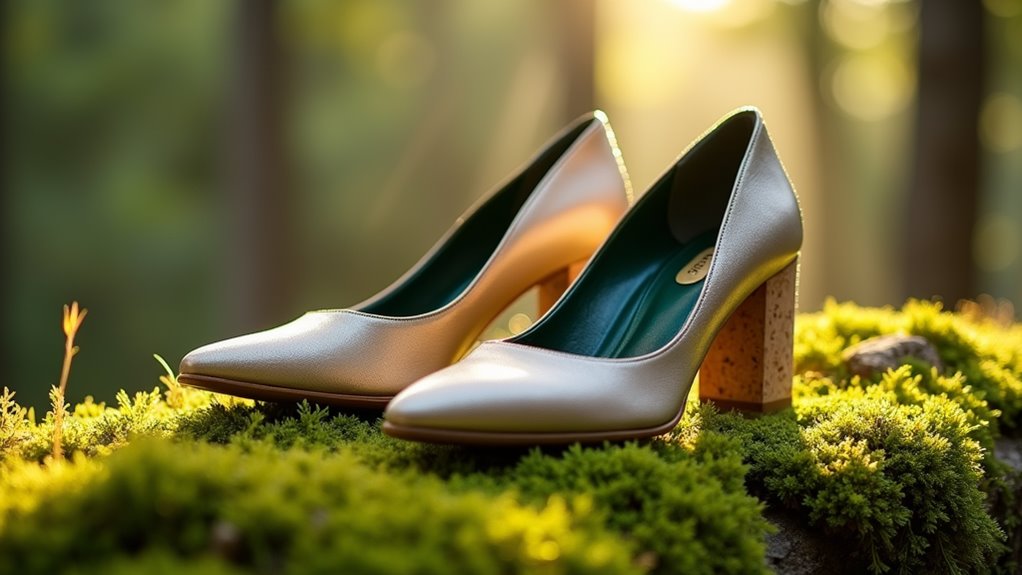There may be products. Products are independently selected by our editors. We may earn an affiliate commission from the links with no charge to you, example: as Amazon Affiliate.
Picture a world where every click of our heels on the pavement leaves a positive footprint on the planet. We’re witnessing a remarkable transformation in the fashion industry as sustainable high heels step into the spotlight. It’s not just about looking good anymore – we’re redefining what luxury means in our closets. While traditional heel production has long been a source of environmental concern, innovative materials and mindful manufacturing are reshaping our relationship with fashion. Let’s explore how this eco-conscious movement is elevating both style and sustainability to new heights.
Key Takeaways
- Sustainable high heels market shows 70% growth since 2015, with consumers willing to pay premium prices for eco-friendly footwear options.
- Innovative materials like apple leather, Piñatex, and mycelium are revolutionizing sustainable heel design while maintaining style and comfort.
- Leading brands like AERA and VEERAH combine luxury aesthetics with environmental responsibility, making sustainable heels increasingly fashionable.
- Circular production methods and recycled materials reduce environmental impact while expanding design possibilities in high-heel manufacturing.
- Sustainable high heels, priced $425-850, offer superior longevity and environmental benefits compared to fast-fashion alternatives.
The Rise of Eco-Conscious Footwear
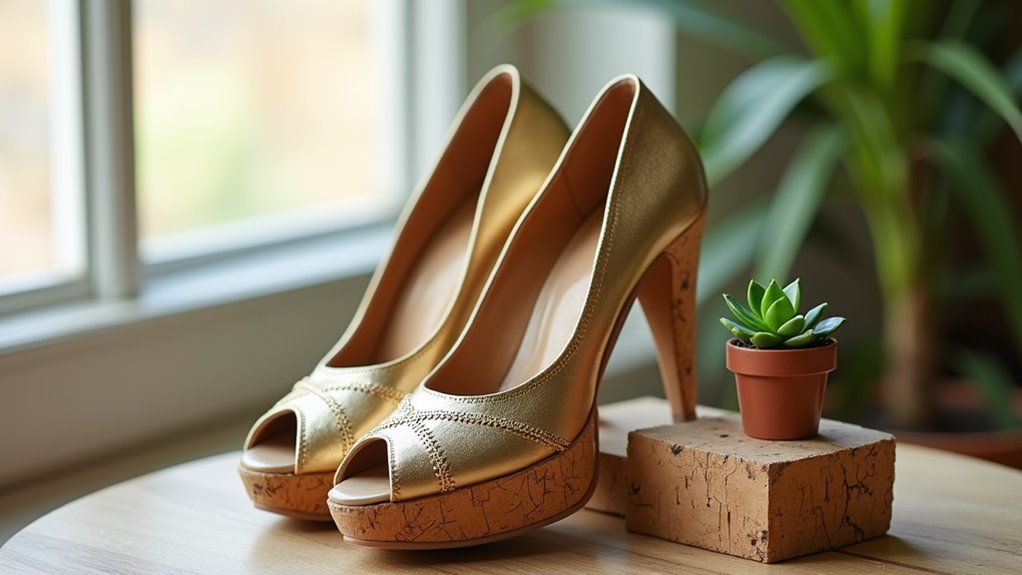
We’ve witnessed a remarkable transformation in the footwear industry, with demand for eco-conscious options surging 70% between 2015 and 2020. This shift isn’t just a passing trend – it’s reshaping how we think about luxury footwear.
Today’s sustainable footwear market is driven by innovative brands like VEERAH and Prota Fiori, who are revolutionizing high heels with eco-friendly materials and ethical production methods.
They’re meeting the demands of conscious consumers, particularly Millennials and Gen Z, who’ll gladly invest 10-20% more in sustainable options.
With projections showing the market reaching $18.2 billion by 2034, we’re seeing a fundamental change in how fashion intersects with sustainability.
From recycled plastics to plant-based leathers, these materials are proving that style and environmental responsibility can coexist beautifully.
Forward-thinking designers are even incorporating ocean waste plastics into their luxury heel collections, turning environmental challenges into fashion statements.
Materials Reshaping Fashion
We’re witnessing a remarkable transformation in high heel production as innovative plant-based materials like apple leather and Piñatex revolutionize traditional manufacturing methods.
The surge in recycled plastics from ocean waste has created new possibilities for fashionable footwear while addressing critical environmental challenges.
These sustainable alternatives, combined with biodegradable design solutions, are proving that we don’t need to sacrifice style for ecological responsibility.
Eco-friendly heels are increasingly available through dedicated sustainable fashion retailers and marketplaces.
Innovative Plant-Based Alternatives
As the fashion industry evolves toward sustainability, innovative plant-based materials are revolutionizing how we think about high heels.
We’re seeing groundbreaking alternatives like Piñatex, crafted from pineapple leaf fibers, and mycelium leather derived from mushrooms, offering exciting new possibilities for eco-friendly footwear.
Forward-thinking brands are leading this transformation.
We’re witnessing VEERAH and Sylven New York incorporate sustainable materials like apple leather and cork into their designs, proving that plant-based alternatives can deliver both style and environmental consciousness.
What’s particularly exciting is how these innovations aren’t just replacements – they’re improvements.
With ongoing research enhancing their performance characteristics, these materials are meeting consumer demands for durability while minimizing environmental impact.
It’s clear that sustainable high heels aren’t just a trend; they’re the future of fashion.
Recycled Materials Gain Momentum
Beyond plant-based innovations, recycled materials have emerged as powerful drivers of sustainable footwear design.
We’re witnessing a remarkable transformation in how high heels are made, with brands like Rothy’s leading the charge by turning plastic bottles into stunning footwear. The surge in eco-friendly materials reflects our collective shift toward more conscious consumption.
Here’s what’s driving the recycled materials revolution:
- A 70% increase in consumer demand for sustainable footwear options since 2015
- Integration of recycled plastics, rubber, and organic fibers in high-end designs
- Development of circular production methods that minimize waste
We’re seeing sustainable footwear brands embrace these materials not just for their environmental benefits, but for their versatility in creating fashion-forward designs.
This movement is reshaping the industry’s future while addressing critical environmental challenges.
Biodegradable Design Solutions
The fashion revolution’s latest breakthrough comes in the form of biodegradable design solutions that are transforming luxury footwear.
We’re witnessing an ingenious fusion of style and sustainability as innovative brands incorporate biodegradable materials like mycelium leather and plant-based materials such as Piñatex into high-end heels.
We’ve discovered that these eco-conscious alternatives aren’t just about reducing waste – they’re reshaping our approach to fashion’s future. By creating shoes that naturally decompose at the end of their lifecycle, we’re moving closer to a true circular fashion economy.
The growing demand for these sustainable options reflects our collective shift toward environmental responsibility.
With materials that maintain both elegance and ecological integrity, we’re proving that luxury footwear can lead the way in sustainable innovation without compromising on style.
Leading Sustainable Heel Brands
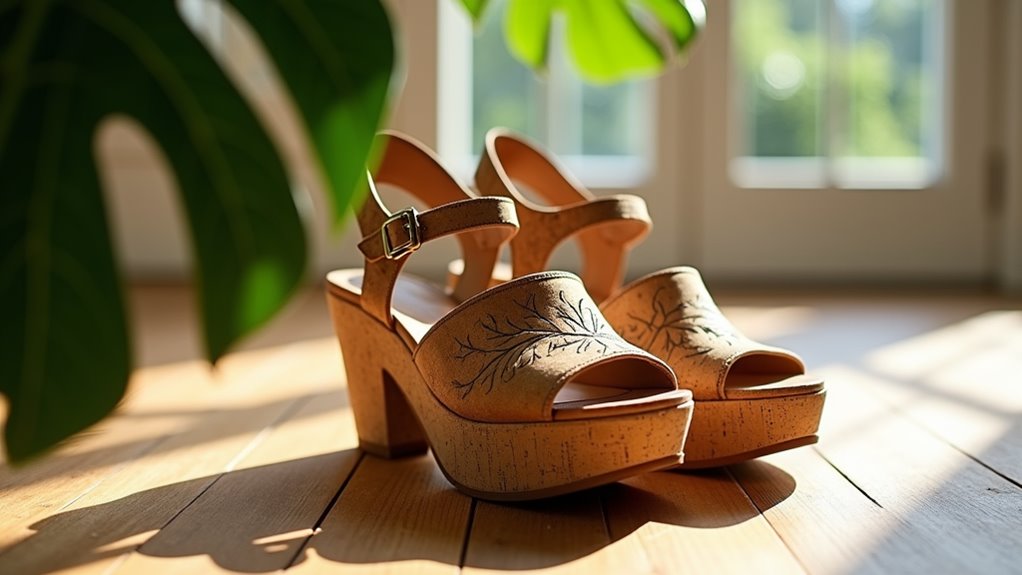
Leading sustainable heel brands are revolutionizing footwear through innovative materials and ethical practices.
We’re seeing remarkable innovations from companies like AERA, with their Italian-crafted luxury heels, and Sylven New York’s groundbreaking use of apple leather. VIVAIA’s creative approach using rice husks demonstrates how sustainable shoe brands are pushing boundaries in environmentally friendly materials.
Key innovations transforming the industry:
- NAE Shoes’ ethical materials and accessible pricing make sustainable fashion more attainable
- VEERAH’s sleek designs prove eco-conscious footwear can be both stylish and sustainable
- AERA’s luxury approach shows high-end fashion can coexist with environmental responsibility
These brands aren’t just creating shoes; they’re redefining what’s possible in sustainable fashion while maintaining style, comfort, and quality.
Design Meets Environmental Responsibility
We’re witnessing an exciting fusion where sustainable high heel design embraces both environmental responsibility and timeless aesthetics, ensuring these shoes remain stylish well beyond a single season.
The innovation in eco-friendly materials, from apple leather to recycled plastics, has revolutionized how designers approach their creations without compromising on style or quality.
Modern shoppers can now explore non-leather heel alternatives that align perfectly with both fashion-forward sensibilities and environmental values.
Timeless Styles Stay Relevant
Modern sustainable high heels are revolutionizing fashion by proving that timeless design and environmental responsibility can coexist beautifully. We’re seeing a transformation in how sustainable materials and ethical production merge to create footwear that’s both stylish and comfortable, while maintaining a lasting appeal that transcends seasonal trends.
Key features driving this timeless revolution:
- Natural color palettes featuring earth tones that remain fashionable season after season
- Innovative materials like apple leather and recycled plastics that age gracefully
- Classic silhouettes that pair with diverse wardrobes and occasions
Brands like Sylven New York and VEERAH are leading this movement, collaborating with designers to create collections that challenge fast fashion’s disposable nature.
We’re witnessing how sustainable high heels can maintain their relevance while reducing environmental impact through thoughtful, enduring design choices.
Materials Drive Innovation
As innovative materials reshape the sustainable footwear landscape, designers are discovering groundbreaking ways to merge environmental responsibility with high-end fashion.
We’re seeing revolutionary eco-friendly alternatives like apple leather and Piñatex transform the way we think about luxury footwear, proving that sustainable materials can deliver both style and consciousness.
What’s truly exciting is how brands are pushing boundaries with recycled plastics, organic fabrics, and biodegradable components.
We’re witnessing cork and other natural materials make their way into heel construction, offering durability without compromising our planet’s resources.
The science behind these sustainable materials continues to evolve, giving us high heels that not only match traditional options in quality but often surpass them.
It’s clear that material innovation isn’t just changing fashion – it’s revolutionizing how we approach luxury footwear altogether.
Pricing and Consumer Value
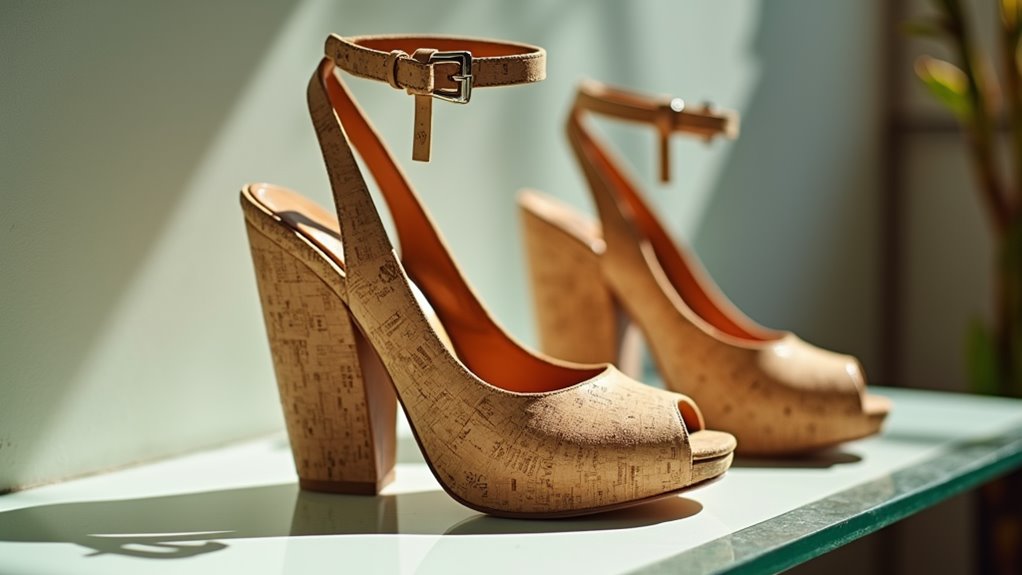
The price tag attached to sustainable high heels reflects more than just fashion – it represents an investment in both environmental stewardship and lasting quality.
When we look at luxury sustainable footwear brands like AERA, we’re seeing prices between $425-850, but these costs align with ethical materials and extended product lifespans.
Today’s consumer awareness shows we’re willing to invest 10-20% more in eco-conscious choices.
Climate adapting heels are becoming increasingly popular as consumers seek footwear that aligns with environmental values.
Let’s consider what drives sustainable footwear value:
- Superior longevity compared to fast fashion alternatives
- Ethical sourcing and production practices that protect our planet
- Accessible pricing through strategic shopping during sales events
Online availability has transformed how we access these conscious choices, making it easier to justify premium pricing while supporting environmental innovation in footwear.
Care for Long-Term Sustainability
Investing in sustainable high heels means embracing a lifelong commitment to their care and maintenance.
We’ve found that using eco-friendly cleaning products not only aligns with our environmental values but also helps preserve the sustainable materials used in these fashion-forward shoes.
Let’s maximize our investment by following specific care instructions from sustainable brands. Regular conditioning and proper storage significantly extend the life of our eco-conscious footwear.
When our heels need attention, we’re embracing the circular economy by choosing to repair and refurbish rather than replace. Whether it’s resoling or reconditioning, these maintenance practices reduce waste and environmental impact.
From cork to recycled materials, selecting eco-friendly heel materials ensures our footwear choices support environmental sustainability from production to maintenance.
Future of Green Fashion
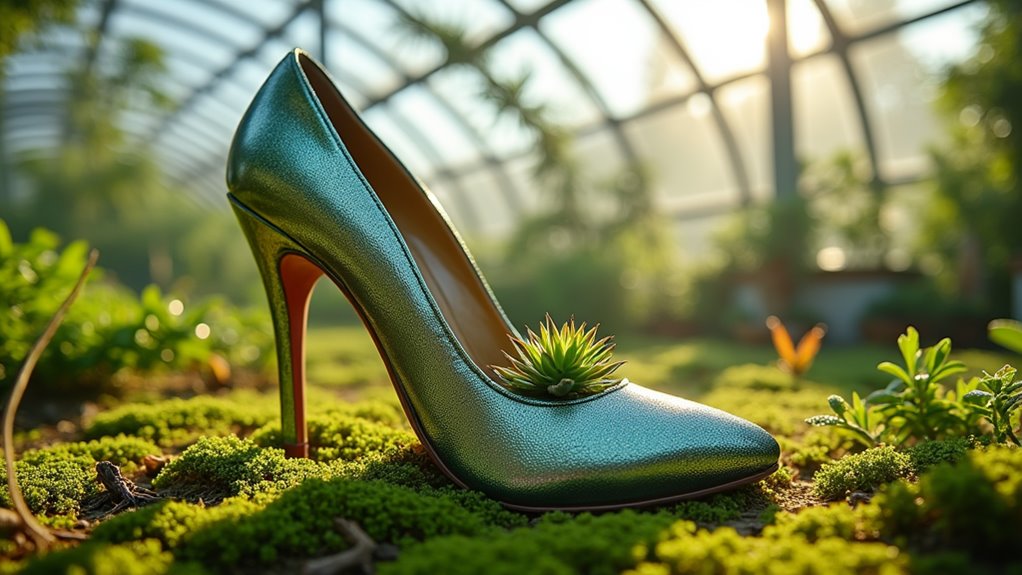
We’re witnessing a transformation in the fashion industry, with sustainable materials and ethical production becoming the new standard. The projected 6.4% growth in eco-friendly footwear signals a fundamental shift in consumer preferences and industry practices.
Leading footwear brands are revolutionizing production through:
- Advanced plant-based leather alternatives that rival traditional materials
- Circular manufacturing processes that minimize waste
- Supply chain innovations driven by emerging regulations
We’re entering an era where sustainability meets style, backed by growing consumer awareness and technological breakthroughs.
As millennials and Gen Z continue shaping market demands, sustainable high heels aren’t just a trend – they’re becoming the foundation of fashion’s future.
This shift represents a broader movement toward responsible consumption that’s reshaping how we think about luxury and style.
Consumers can now easily access sustainable heel options through dedicated online fashion marketplaces.
Conclusion
We’ve witnessed sustainable high heels evolve from a niche market to a fashion revolution. As they say, every step counts, and our footwear choices now reflect our commitment to Earth’s future. Through innovative materials, conscious design, and mindful consumption, we’re redefining luxury while reducing our environmental footprint. By embracing these eco-friendly alternatives, we’re not just following a trend – we’re walking towards a more sustainable tomorrow.

